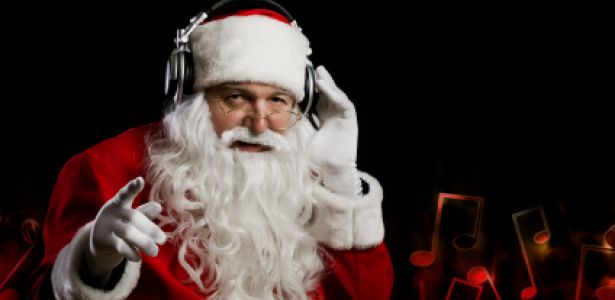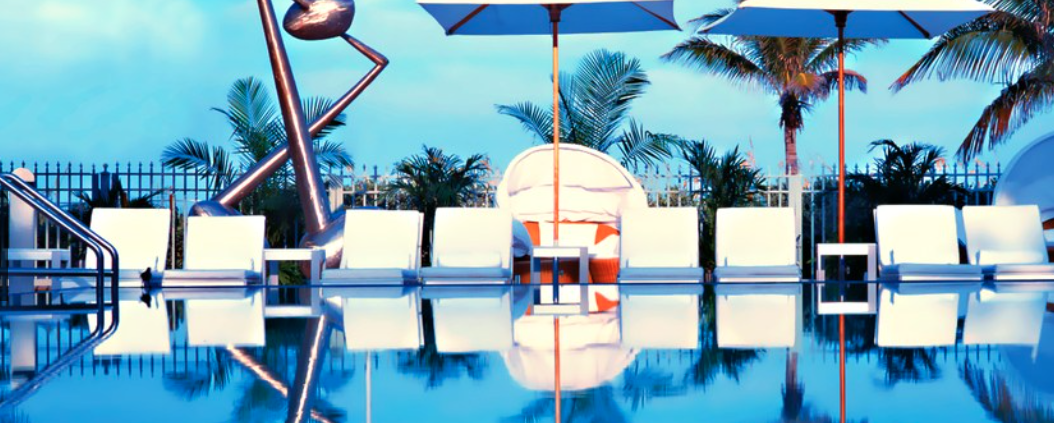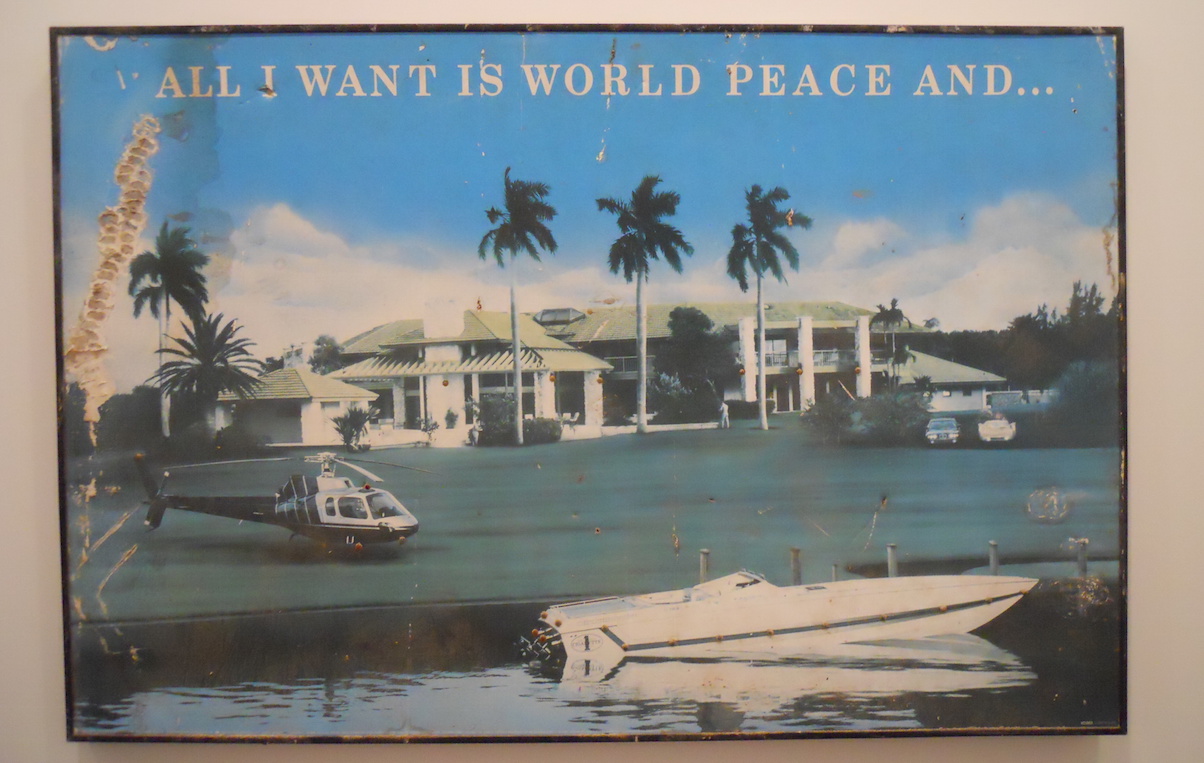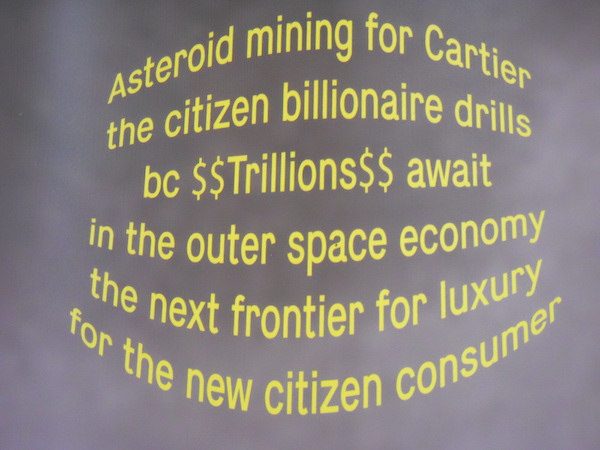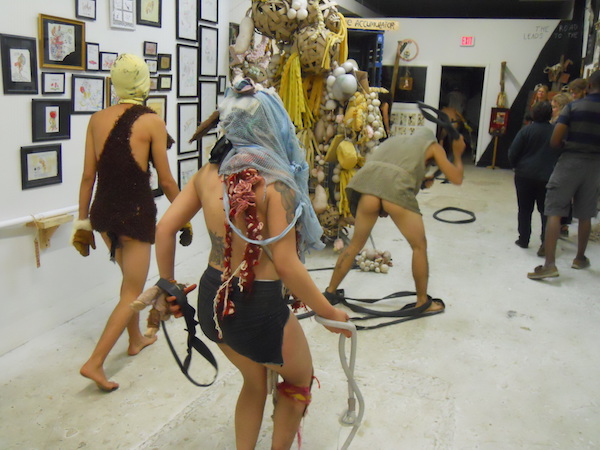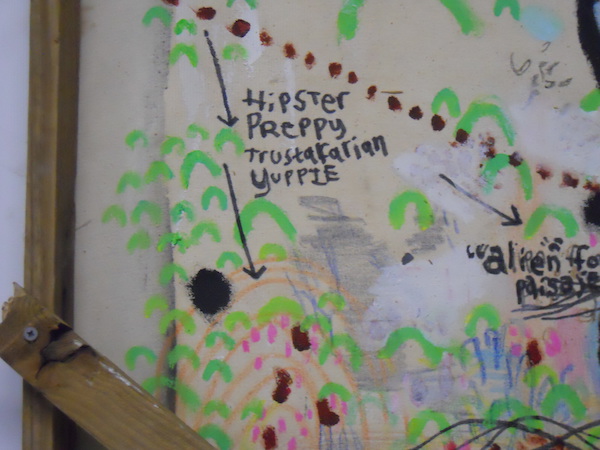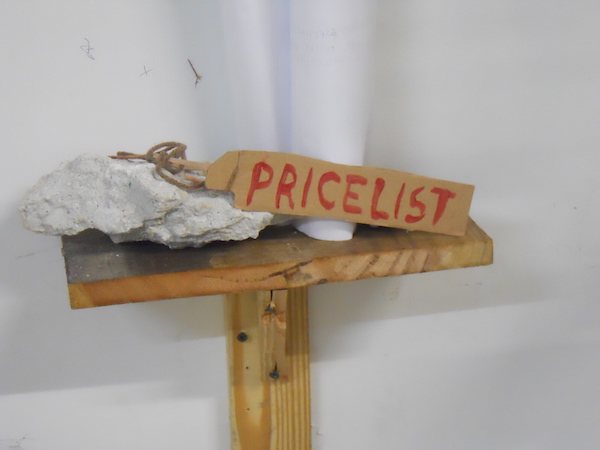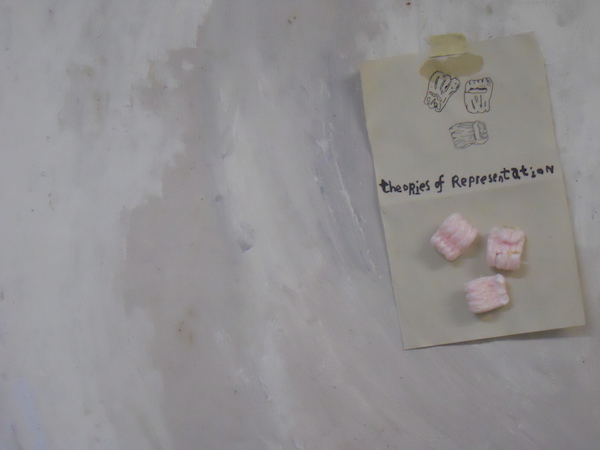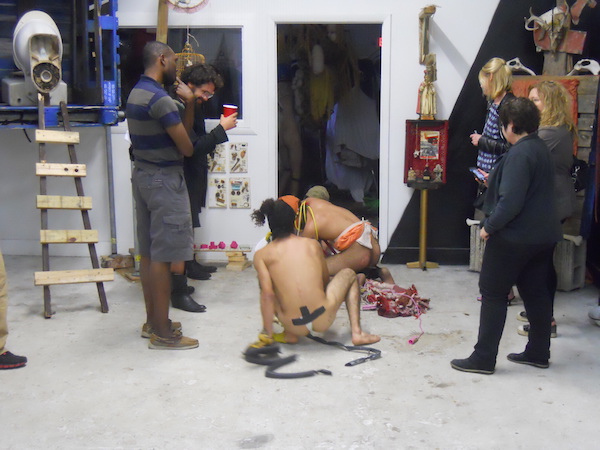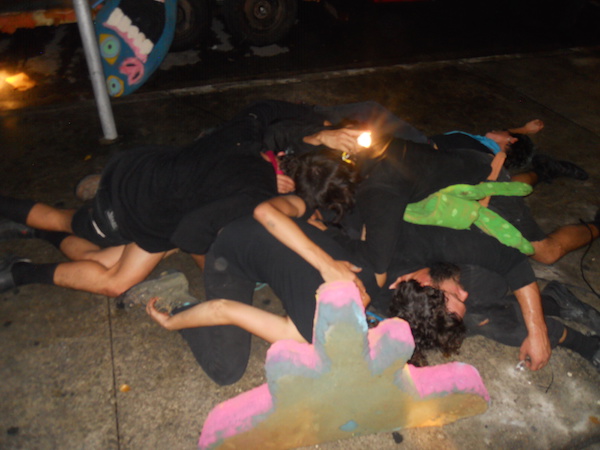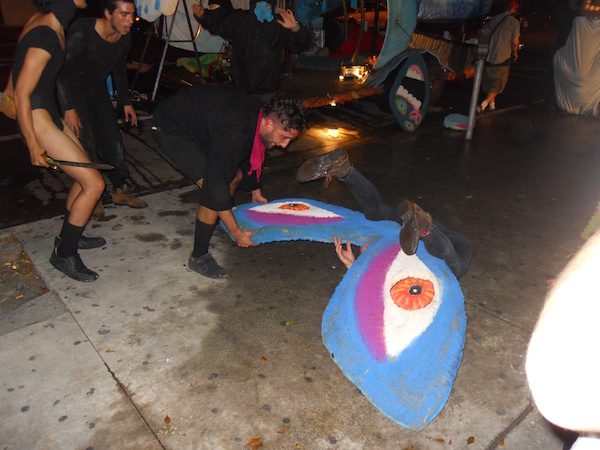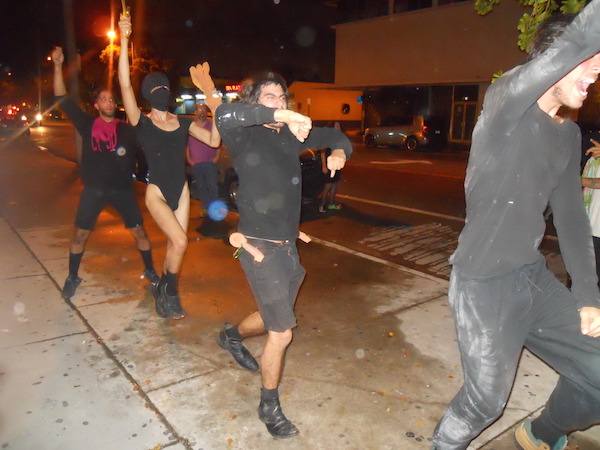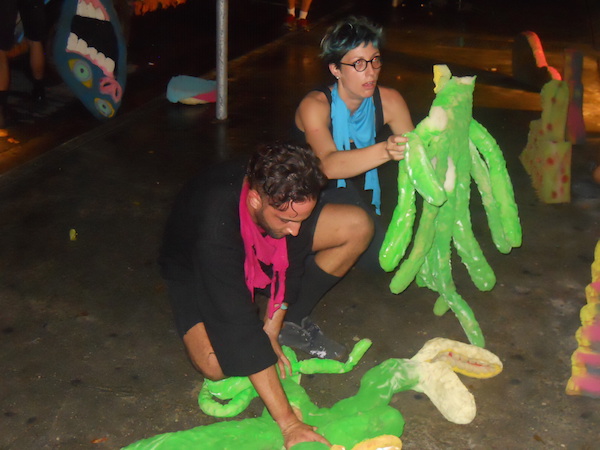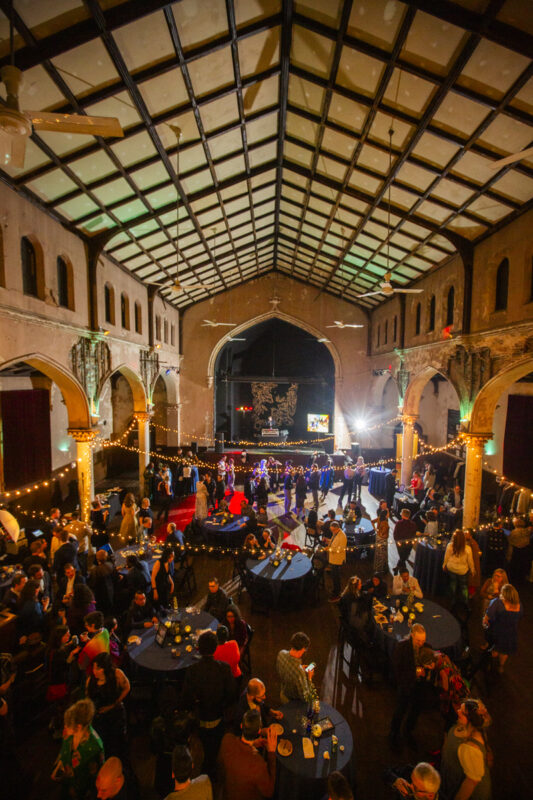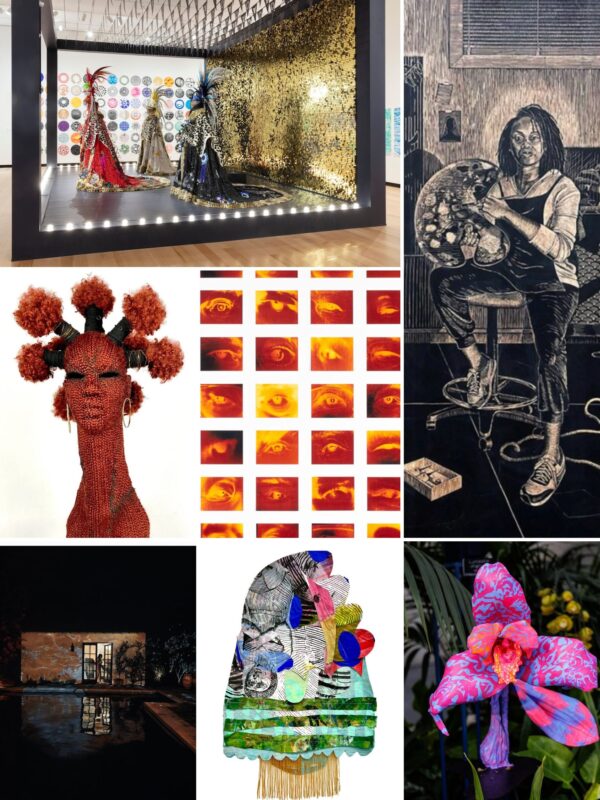Michael Farley’s Art Basel Miami Beach Roundup
About a month ago, I called Art Basel’s PR firm to inform them I would be covering the fair for BmoreArt and would require a press pass. While the woman on the other end of the phone took my information, she apparently googled us and wanted an assurance that BmoreArt wasn’t coming to do another “Overheard at Art Basel.” I’m afraid I have to disappoint her. Everywhere I went, the old adage “Don’t Shit Where You Eat” seemed to be on somebody’s collagen-plumped lips. It’s an appropriate caveat for a week in which everyone seems to mix business with pleasure, nepotism with professional grudges, selling-out with institutional critique, and (most dangerously) champagne with whatever sugary cocktail brand is sponsoring a given event.
That exchange was actually one of the least surreal interactions I had with a PR firm this year. For the first time in my life, I was un-invited from a party! Just before a Jeffrey Deitch/Tommy Hilfiger event that featured Miley Cyrus—an event that sounds like the punch-line to a joke from the gossip writers at The Onion—I received a last-minute reply to my RSVP asking me not to come because too many more important people were expected to attend. I didn’t even bother attempting to crash the event, but I’m glad Artslant’s Rob Goyanes did, because the story made for one of the best pieces of Basel writing I’ve seen in a long time.
Thursday night, I received another email reminding me that I had RSVP’d to an equally bizarre art happening that Marlborough Chelsea was hosting at The Miami Beach Edition. The premise was intriguing enough— “The work employs a mix of theatrical genres ranging from the slide lecture, the fashion show, the sculptural display, and the live musical act as a means to illustrate the fictional parallel world of the San San International, a ‘hallucinatory mega-convention of staggering proportions’… Jonah Freeman and Justin Lowe create immersive environmental installations that play on ideas of drug culture, psychedelia, architecture, and film.
Beginning with their first official collaborative piece, ‘Hello Meth Lab in the Sun,’ the artists have created a series of recurring narratives that are present throughout several connected works…” But I was mostly caught off-guard by the promoters’ decision to include both “Art World” and “Social” lists of important people who were supposedly attending the event in their email reminder. Highlights from the latter list included Adrian Grenier, Charlotte Sarkozy, and Scout Willis. I want to think that this was a component of the absurdist art work and not just a marketing ploy of a somewhat questionable taste level. Either way, I might just steal this tactic and conclude every artist statement with “Adrian Grenier is going to be there.”
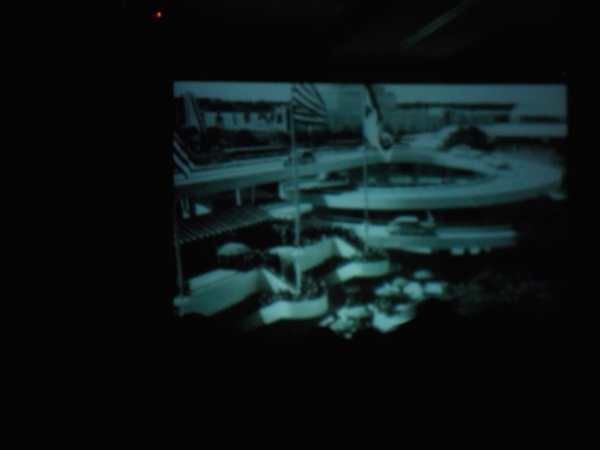
When I arrived at the Edition, I was funneled into a roped-off area behind the lobby full of people who can only be described as multiple copies of the Marnie character from HBO’s “Girls.” My plus-one was running late, and for the first time at an art event, I found myself incapable of making small talk with any of the other hundred-or-so attendees. After about an hour, we were allowed into a crowded auditorium. Half an hour later, a quiet slideshow lecture began. The dead-pan presentation described the history of the “San-San International,” a cult that starts a planned community organized around a space that evolves into a convention center.
At first, it’s uncertain whether or not the story is fictional. The narrative gradually becomes more and more outlandish, as the convention center and surrounding city grow and morph into different found images of modernist megaprojects intercut with tableaus of New Age practitioners. It’s a funny premise, and I’m impressed by the fact that a lot of the dialogue seemed to be ad-lib in response to the images. Most of the Marnie crowd, however, seemed disinterested. People were taking selfies, getting up to refill drinks, answering phone calls, and at one point actually slow-clapping in a rude attempt to accelerate the slow-moving presentation. I found myself getting a little bored as well—once the parallels with the art fair became obvious and the performers were essentially just pointing and laughing at goofy advertisements from the 70’s and 80’s, I was ready to move on.
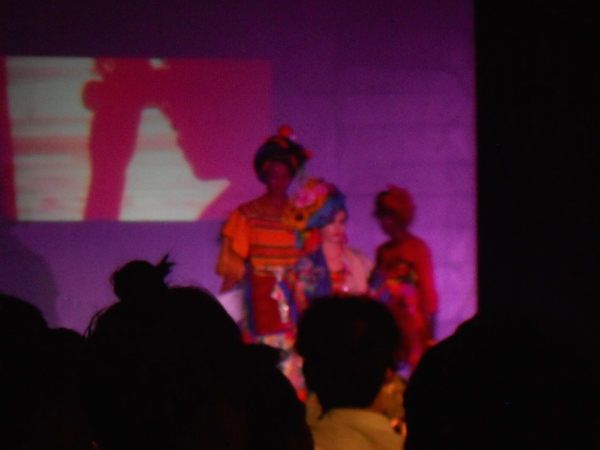
Suddenly, the lights came up and dozens of models poured into the space like a runway show. Each set of models was dressed like a different hyper-stylized subculture, often a fictitious one or hybrid of several. It didn’t seem obviously connected to the slideshow presentation, but both offered a somewhat-fresh take on the ABMB tradition of institutional critique. I still had the schedule of panel discussions and lectures being offered at the convention center tucked into my bag. Of course, I didn’t make it to any of them— Miami Art Week is all about a knowingly farcical spectacle, and the actual high-brow content offered at the convention center is often totally drowned out by the chorus of its parodies. The didactic-presentation-turned-absurdist-cocktail-party and the marketing-event-selling-nothing-but-the-idea-of-branding each represent a medium that, in a sense, has become ABMB’s tongue-in-cheek lingua franca.
The next evening, back in Little Haiti, I popped into the exhibition “Luxury Face” at the appropriately-named gallery Guccivuitton. Here, again, the work was a parody of the main fair’s institutional vocabulary and commercialism. Ida Eritsland, Geir Haraldseth, Agatha Wara, and Bjørnar Pedersen collaborated on a series of digitally printed banners evocative of the art fair advertisements that hang from Miami Beach’s lamp posts. Of these, my favorite reads “Asteroid mining for Cartier the citizen billionaire drills bc $$Trillions$$ await in the outer space economy the next frontier for luxury for the new citizen consumer.” This one stuck with me because I had recently had a dream that I was attending the Art Basel of the future—a high-security fair so exclusive it takes place on a space station in geo-synchronous orbit above Miami Beach.

Overall, though, I found these a bit obvious. We get it. Rich people buy art. Nearly every satellite exhibit in “fringe” neighborhoods in mainland Miami seemed preoccupied with mocking the conspicuous consumption at magazine-sponsored parties in Miami Beach rather than inspiring a wholly different experience beyond a knowing eye roll to the audiences who attended these more “accessible” exhibitions. It also bothered me that these functioned less like a parody of bland commercial graphic design and more like a regurgitation of the trendy stock-photo-inspired-artwork that I’ve been bored with for the past year or so.

I will give the artists here credit, however, for injecting a more specifically political critique that’s usually absent from this type of “post-net” art. In another banner that I like, the text reads:
Income rises
Sea level rises
Temperature rises
Twilight at noon
Final days
Still, I’m not convinced that it’s fair to hate the art world for creating and selling objects, especially when that critique is vocalized via the creation (and presumably sale) of one’s own objects. The environmental impact of the consumption that happens at Basel is probably a negligible drop in the sea compared to that of Black Friday, which happens just a week before. Let alone the numerous real estate developments plowing through South Florida, the military industrial complex, or the fossil fuels that carried us all to Miami from our distant liberal oases scattered across the globe. Hell, I for one am glad the wealthy people of today want to hang art on their walls instead of the heads of animals they killed on safari. In the interest of picking our battles, I have to ask: as a generation, is making art about hating people who like art really the best use of our time?
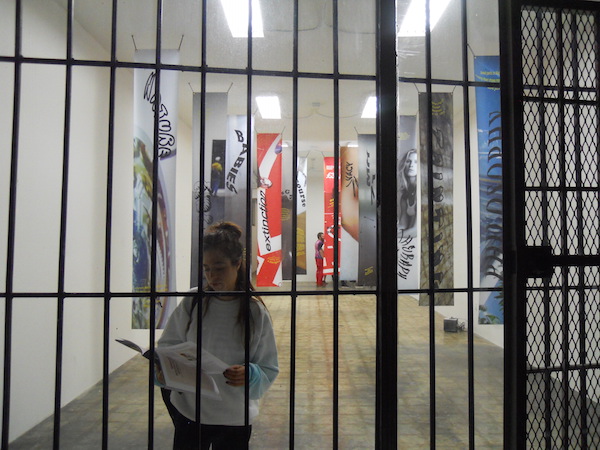
I’m probably not being fair to the producers of “Luxury Face.” In another context, I almost certainly would’ve liked these more than I did here. And I myself have certainly made more than my fair share of art-fair-critiquing artwork. I’m always just a little frustrated by the time this weekend rolls around because I feel like I’ve just read the same artist statement in different fonts a hundred times.
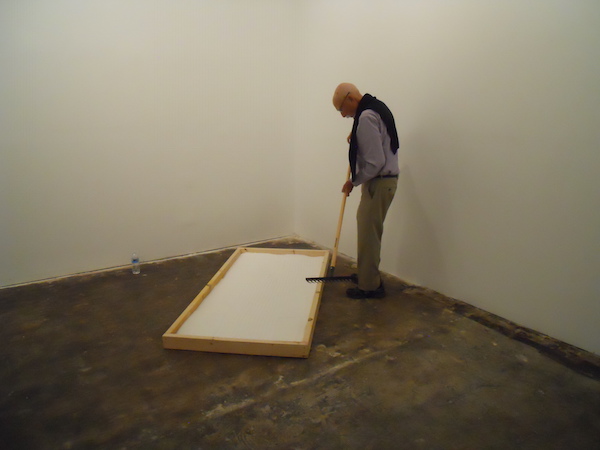
Case and point: the two shows at the new Bill Brady Gallery next door to Guccivuitton. In the front room, there’s a group show called “Cold Sweat” that features this poster (pictured at top). Through the magic of Google’s reverse image search, I found out that it’s a found print (the original was a popular poster in the 70’s). I like this piece more now that I know the artist didn’t create it. I love that it’s damaged and the pock-marks almost look like bullet holes. I like that it was intended to be funny to one generation, and ended up acquiring more poignancy (and dark humor) through the passing of time. On a totally unrelated note, there was also a piece that consisted of this guy tending a zen garden in the opposite corner.
In the back galleries, I almost-reluctantly fell in love with the solo show “Please Don’t Lick: Landscape Paintings by Dustin Pevey.”
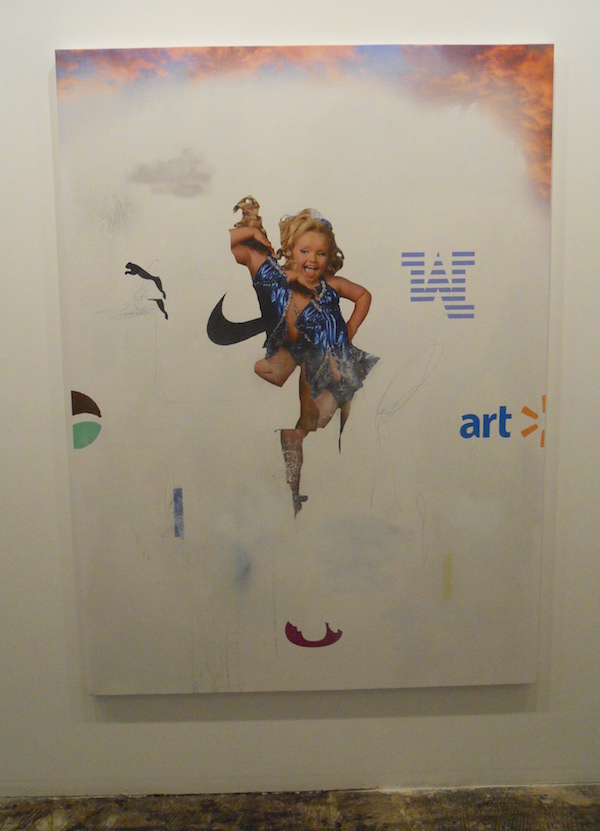
I didn’t want to like these paintings because they are so very much like the trendy, ironically-corporate, seriously-successful Tumblr art that’s left Brooklyn’s transplant-dominated art scene (The*) Jogging in place for the past few years (*bad pun intended). But these have a depth—both physically and conceptually—that seems to resist translation to photography and subsequent re-blogging. Unlike a vector image of a pixelated Nike swoosh, these are a little less obvious and have a lot of traces of the human hand. There are moments where painterly washes partially obscure hard-edged logos or inkjet-printed imagery—details that are best observed in-person and not in a thumbnail image online. The collage-like components—symbols of consumption or desire—are all fragmented but still recognizable. As disembodied parts of a whole, some of the images themselves are somewhat macabre, but still function as a synecdoche referring to their respective brands like a severed hand that refuses to stop pursuing the protagonists of a horror film.

These symbols—oil company logos, sex objects, and, yes, Nike swooshes—float in a painterly space with contemporary indicators of “cool”—such as spray paint marks or drips—sitting atop or receding into a sfumato void. The effect is the production of a decorative motif in which subjects the art world/internet considers “beautiful” (for lack of a better word) are reduced to aestheticized embellishments in a sort-of updated Millefleur pattern tailored to predictable contemporary tastes.
Also on the same block, the gallery Space Mountain hosted a two-person show by James Concannon and Kalan Sherrard. The full title of the show is “AOS Internationale presents ‘Folding The Black Flag,’ an Entre into Revolutionary Nihilist Pataphysics” and it offers a much, much more subtle commentary on the commercial art fairs.
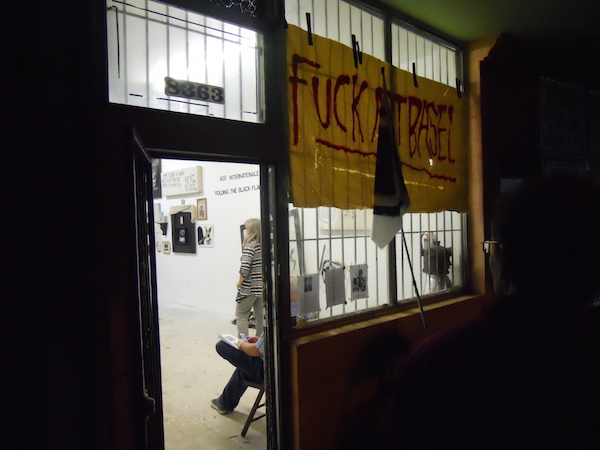
Just Kidding! In their sprawling artist statement, Sharrard and Concannon (but mostly written by Sherrard) consider “folding” from the perspective of compressing 20th century revolutionary art history—questioning whether the aesthetics and politics of the Black Panther Party and the Dada movement could coexist in one point in space/time, for example. Fittingly, their pieces seem to draw inspiration from various countercultures; punk graphic design, surrealist assemblages, Basquiat-esque paintings, Situationist collage, and puppets made from trash that have a somewhat “Burning Man” look overlap into a chaotic anti-shrine to angst and rebellion.
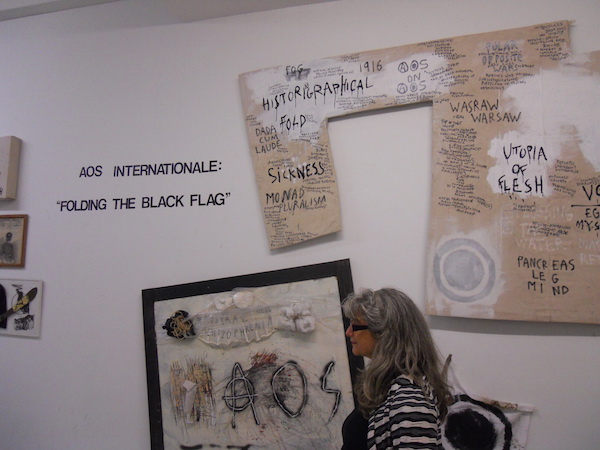
This night, to coincide with all the other openings on our block, AOS Internationale performed a “noise opera” with various participants activating the space with abrasive sounds, sights, and smells.
The artists also consider “folding” from the perspective of “surrender.” There’s a nihilist overtone to the artwork that’s an odd foil to some of the labor-intensive or personal processes on display. Many surfaces are covered with self-deprecating graffiti or artspeak that’s self-aware of its own pretentiousness. It’s odd to approach this work, because it’s so cynical in terms of its content but so earnest in terms of its politics.
Similarly, a carefully-crafted object might sit next to a broken toy that seems to scream “fuck it” (or might just have “fuck it” literally scrawled across itself in childish script). Curiously, there’s a level of restraint exercised in Concannon’s solo work that seems contradictory to Sherrard’s deliberate bedlam (which looks a little like a version of Baltimore’s Paper Moon Diner that would never pass a health inspection). Some of Concannon’s work displays a sophisticated design sense and capacity for found-object alchemy—using an economy of materials and language, certain pieces feel more complete, poetic, and “precious” than the artist seems to admit. Conversely, Sherrard’s work implies a constant state of over-accumulation, ongoing process, and rot. It’s not necessarily my personal style, but it definitely has a voice that’s loud—and an audience.
The problem is, that voice is so loud and deliberately contradictory that it makes a two-person show difficult to take in for the viewer. The more times I visited this gallery over the course of the week, the more I realized that the two bodies of work have less and less in common than first meets the eye. What Concannon and Sherrard share is a bombastic pessimism that’s oddly liberating—art, theory, and culture at large are looked upon with such apparent disdain that the two artists have no qualms about mining society’s literal and conceptual detritus for material to mash-up without discretion.
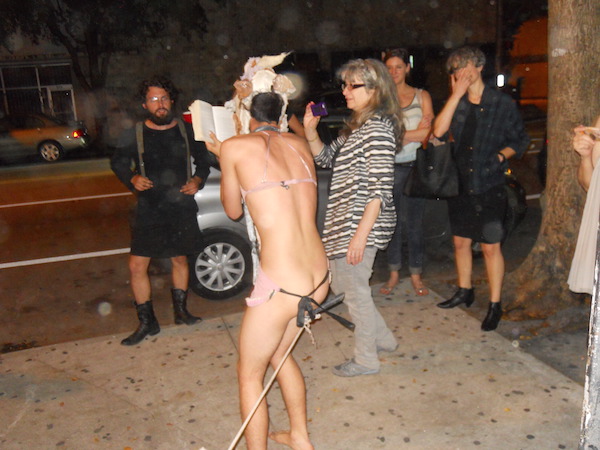
Friday night’s Noise Opera spilled out of Space Mountain and turned into a spontaneous parade down NE2nd Ave’s little gallery row, leading visitors/participants to the closing reception of the show I co-curated with Liz Ferrer at Zones Art Fair: “The ‘Planet Hollywood’ of Newer Genres,” in which Kalan Sherrard was also performing. There, a piece by MICA alum Antoinette Suiter was being performed. I know I’m probably not supposed to say this because this was my own show, but Antoinette’s piece was one of the smartest works to flirt with institutional critique that I saw all week. It consisted of two performers carrying a viewer around the gallery on a bench that was equally evocative of a processional litter, theme park rides, and art handling. The viewer/tourist was carried to various “stations” of wall text interspersed among the rest of the exhibition’s title cards. In the beginning of the “ride” the text is comprised of didactic facts about the history of the actual restaurant chain “Planet Hollywood”. The text gradually becomes less dry as one circles the gallery, including quotes from Kenneth Anger’s “Hollywood Babylon”, Misfits lyrics, and ultimately this quote from Keith Barish:
“There’s no Hollywood. You come here and you see the Paramount gates and the footprints at Mann’s Theatre, and that’s it. ‘Hollywood’ is still working, but there isn’t much to look at…”
I love how this piece directly relates to the culture of display and its role in the tourism sector. For all the work I saw that attempts to bite the hand that feeds us—the art market and its commercial sponsorship—there’s very little discussion on the enormous economic impact art has on tourism and the branding of place in Miami. Little Haiti got a lot of attention this year, but it always bothered me when people excitedly proclaimed that shows like ours were helping “transform” the neighborhood into the next Wynwood. I kind of hate Wynwood (a former industrial district developer Tony Goldman bought and re-branded as an arts “neighborhood” after observing the influx of capital that Art Basel brought to Miami). When people ask me if Wynwood is “where all the cool people in Miami live,” I usually give this analogy: “Wynwood is like a strip mall of art-themed bars that is to ‘cool neighborhood’ what ‘The Rainforest Café’ is to an actual rainforest.” It is a site of consumption, not production. For example, it has commercial galleries but no art supply store. It has overpriced restaurants but no grocery store. For that matter, I don’t think Wynwood has actual residents to buy groceries, just tourists who drive in to take selfies with extremely sterile, commissioned “street art.”
Although this specific local example was probably not what Suiter had in mind, her piece’s musing on theme restaurants, “Hollywood” as a salable abstraction, and its relationship to Hollywood the physical place stuck with me. What I like most about this piece, however, is that it doesn’t shout an obvious political statement—it’s mostly fun and humorous while providing kindling for discourse.
The above video (shot by Sergio Coyote) also features a clip of Miami local David Rohne. His performance was extremely unsettling and oddly beautiful at the same time. He arrived in prisoner “drag” and eerily began lip-synching Billie Holliday’s “My Man.” The piece was really moving on its own, but in the context of a low-income minority neighborhood in the midst of a national discussion on the failings of our “justice system,” it felt especially poignant.
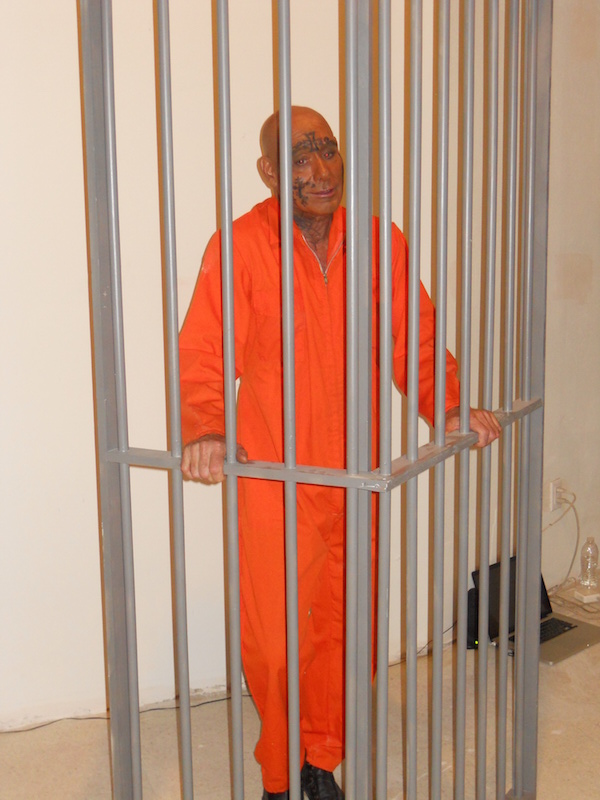
But the strangest performance came from Goucher alum Jamie Marsh, who donned an uncannily androgynous mask and wildly danced to his own music and video projections. At the end of his acrobatic contortions, a female computer-generated voice (like the ones that announce flights or subway arrivals) informed the audience that Marsh was selling dildos made from a cast of his own penis that contained USB drives with MP3s of his music. Of all the artists in “The ‘Planet Hollywood’ of Newer Genres,” Marsh took the most creative approach to answering our call for indexical remnants of non-object-based art practices.
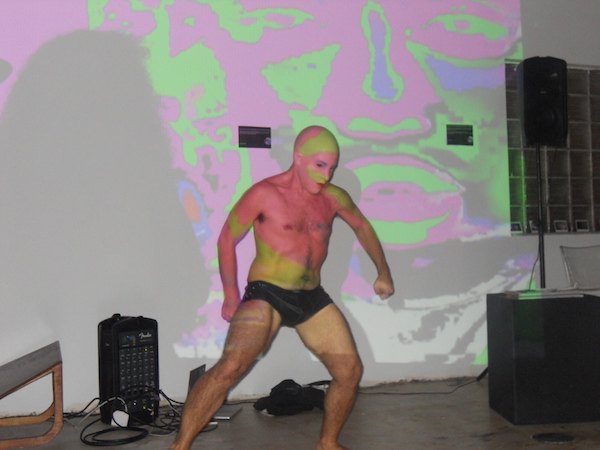

I spoke to my co-curator Liz Ferrer about our uneasy relationship to the area’s gentrification. All the art events happening in Little Haiti, collectively branded as #ihaitibasel—whose content was intended as a critique of the commercialism at the convention center and big tent fairs—might very well have a more lasting effect on a far more insidious and detrimental process of capitalism than the mere sale and purchase of paintings. Zones Art Fair was allowed to use the space for free in an attempt to bring attention (and investment) to the neighborhood during Basel. The developers/our benefactors are renovating the building (a former church) into “co-working” office spaces and thus desire an association with “creative types” or “outside-the-box-thinking” or whatever other slogan one uses to market co-working office space (sustainability? Can we start calling “emerging” neighborhoods “liminal spaces”?). This arrangement often led to tense tongue-biting when interacting with the investors, who own a sizable chunk of the neighborhood. Liz and I agreed that “biting the hand that feeds you” had indeed become the new “shitting where you eat.”
In a perfect moment that our conversation seemed to conjure into existence, local artist/troublemaker Richard Haden happened to walk into the building at the exact same time as one of the owners. His dog squatted over the “kooky” hand-shaped rug in the lobby and took a big dump on it.
Obviously, the owner of the building did not react favorably to this event and threatened to shut down the event (more so than the turd, I think he was disappointed—I believe he expected “art openings” to look more like the types of events that Adrian Grenier and Charlotte Sarkozy say they are going to attend than a procession of nearly-nude crust punks humping their way down the sidewalk). I’m going to have to paraphrase here, because I don’t fully remember, but Richard Haden and one or two bystanders interjected something along the lines of “FUCK YOU, YOU GENTRIFYING CAPITALIST FUCK! EVERYONE SHOULD TAKE A SHIT ON YOUR STUPID HAND RUG!” Miraculously, Liz managed to broker an uneasy peace between all parties involved and the show was allowed to go on.
Outside, the Puerto Rican puppet troupe Poncili Creacion pulled up on a giant whale puppet trailer. Their high-energy performance spilled off the truck and onto the sidewalk… stripping the whale’s foam anatomy away from the structure and reanimating it as a new cast of characters. I am not entirely sure what the narrative here was, but it was really really cute and really really fun to watch.


After our reception, Monica Lopez de Victoria drove Baltimore’s Kevin Blackistone and me back to the beach to catch VH1’s Scope party. It was awful. Coming from the lukewarm-Franzia-fueled DIY fun of #ihaitibasel land, the flashy megaclub full of people who looked more like the cast of the Jersey Shore than denizens of the art world was an abrasive experience to say the least. We walked around, bewildered and invented a game where we pointed at people making “duckface” for photos and speculated what brought them to Basel. “She’s on the board of directors at LACMA!” “That dude in the Armani Exchange shirt fist-pumping to a song about boobs totally writes for Art in America!”
Like my fairy godmother, Liz texted me to “come outside.” When Monica, Kevin, and I left the club, we were greeted by Liz, Kalan, and all of Poncili Creacion driving the whale towards us! We jumped on board and rode around South Beach dancing to a boom box until 3 AM. There’s really no better feeling than sitting on a steel whale spine 12 feet above Collins Ave and feeling the wind in your hair and having limousines full of drunk people open their sunroof to blow you kisses and inspiring bored people at bus stops to dance with a truckfull of adorable Puerto Rican punk boys at red lights. Of all my Art Basel memories (and probably many things I’ve done and not remembered) this was somehow the most glamorous.
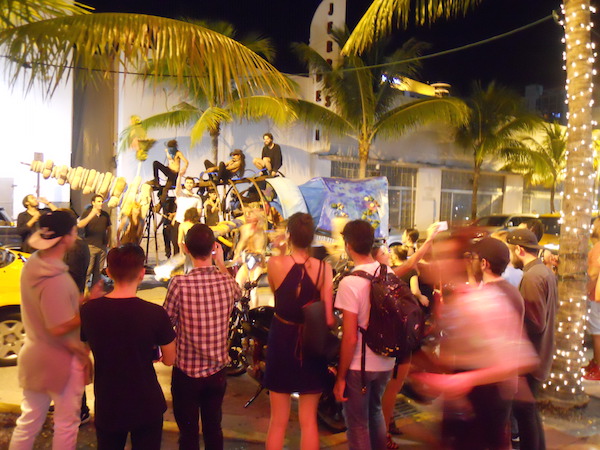
TO BE CONTINUED … to read the second half of this article, click here.
Author Michael Farley was born at John’s Hokpins Hospital, attended MICA for a BFA in Interdisciplinary Sculptural Studies, and recently received an MFA in Imaging Media and Digital Arts from UMBC. He has a complicated relationship with institutional critique. Although he went to digital art school, he has no website, but did switch to electronic cigarettes.
